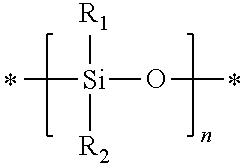Prepolymers suitable for making ultra-violet absorbing contact lenses
a technology of ultraviolet absorption and polymerization, applied in the direction of optics, instruments, optical elements, etc., can solve the problems of mold size fluctuations, molds may undergo non-uniform shrinkage, and molds inherently have unavoidable dimensional variations
- Summary
- Abstract
- Description
- Claims
- Application Information
AI Technical Summary
Benefits of technology
Problems solved by technology
Method used
Image
Examples
example 1
[0126]Oxygen permeability measurements. The oxygen permeability of a lens and oxygen transmissibility of a lens material is determined according to a technique similar to the one described in U.S. Pat. No. 5,760,100 and in an article by Winterton et al., (The Cornea: Transactions of the World Congress on the Cornea 111, H. D. Cavanagh Ed., Raven Press: New York 1988, pp 273-280), both of which are herein incorporated by reference in their entireties. Oxygen fluxes (J) are measured at 34° C. in a wet cell (i.e., gas streams are maintained at about 100% relative humidity) using a Dk1000 instrument (available from Applied Design and Development Co., Norcross, Ga.), or similar analytical instrument. An air stream, having a known percentage of oxygen (e.g., 21%), is passed across one side of the lens at a rate of about 10 to 20 cm3 / min., while a nitrogen stream is passed on the opposite side of the lens at a rate of about 10 to 20 cm3 / min. A sample is equilibrated in a test media (i.e., ...
example 2
Preparation of Polydimethylsiloxane (PDMS) Crosslinker A
[0133]In a 4 L beaker dissolve 700 grams of PDMS diamine KF-8008 in 1000 grams of hexane. In a 2 L beaker, dissolve 25 grams of sodium carbonate monohydrate in 1.6 L of 5% NaCl solution. Add both solutions into a 4 L reactor and stir at 600 rpm for 30 minutes. Prepare a solution containing 15 grams of acryloyl chloride and 72 grams of hexane. Add this acryloyl chloride solution to the stirred mixture in the 4 L reactor drop wise over 1 hour. Leave the mixture stirring for an addition hour after addition is complete. Then add 200 mL of saturated NaCl aqueous solution. Continue stirring for another 10 minutes. Stop stirring and allow phases to separate overnight. Remove the aqueous layer and add an additional 200 mL of DI water to the organic layer. Stir the mixture at 250 rpm for 10 minutes. Stop stirring and allow to phases to separate. The aqueous layer is removed. The DI water addition, stirring, and settling steps are repeat...
example 3
[0146]A1. Preparation of UV Absorbing Macromers Containing Norbloc
[0147]A 2-L jacketed reactor is equipped with a heating / chilling loop, reflux condenser with N2-inlet adapter, two septum-inlet adapters with stopcock and side-arm, a thermocouple adaptor, and overhead stirring is used. A solution is generated by dissolving 54.86 g of PDMS crosslinker A produced in Example 2 and 6.22 g of PDMS crosslinker B produced in Example 2 in 137 g of 1-propanol. This solution is charged to the reactor and cooled to 4° C. The solution is degassed by evacuating to less than 5 mBar, holding at vacuum for 15 minutes, and then re-pressurizing with nitrogen. This degas procedure is repeated for a total of 5 times.
[0148]In a separate 500 mL flask equipped with a magnetic stir bar and a vacuum-inlet adapter with valve, 2.84 g of cysteamine hydrochloride is dissolved in 87 grams of 1-propanol. Add a stir bar to the mixture and stir to dissolve.
[0149]In another 500 mL flask equipped with a magnetic stir ...
PUM
| Property | Measurement | Unit |
|---|---|---|
| Fraction | aaaaa | aaaaa |
| Fraction | aaaaa | aaaaa |
| Pressure | aaaaa | aaaaa |
Abstract
Description
Claims
Application Information
 Login to View More
Login to View More - R&D
- Intellectual Property
- Life Sciences
- Materials
- Tech Scout
- Unparalleled Data Quality
- Higher Quality Content
- 60% Fewer Hallucinations
Browse by: Latest US Patents, China's latest patents, Technical Efficacy Thesaurus, Application Domain, Technology Topic, Popular Technical Reports.
© 2025 PatSnap. All rights reserved.Legal|Privacy policy|Modern Slavery Act Transparency Statement|Sitemap|About US| Contact US: help@patsnap.com



